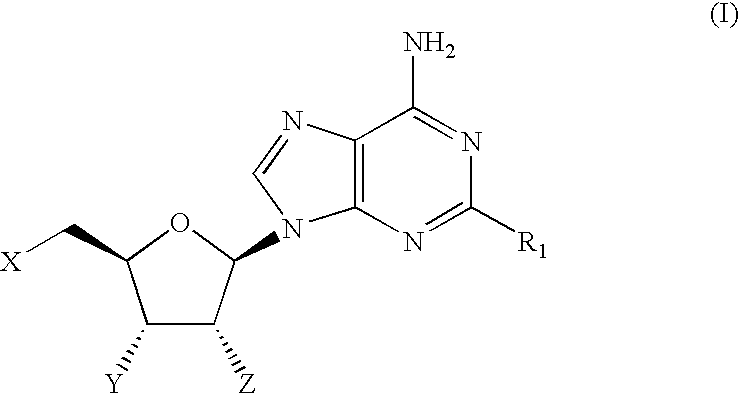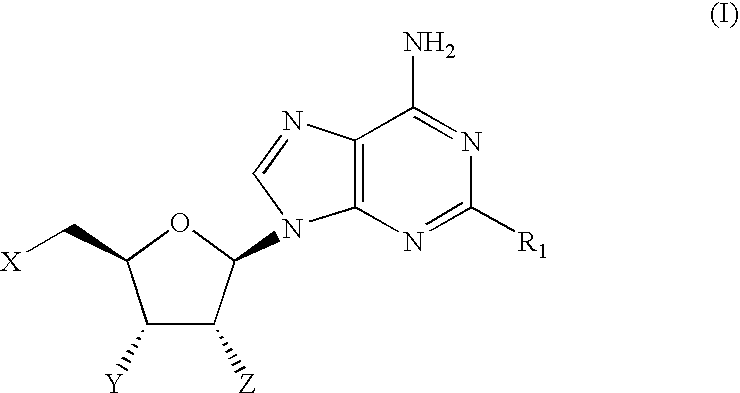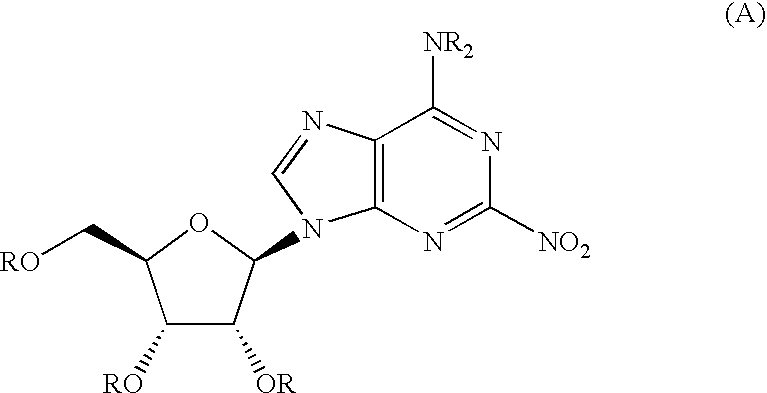Therapeutic compounds
a technology of adenosine receptor and therapeutic compounds, which is applied in the field of compounds, can solve the problems of preventing affecting the development of adenosine-based therapies, and causing adverse side effects of adenosine receptor agonists, so as to increase the affinity and increase the affinity of adenosine receptors
- Summary
- Abstract
- Description
- Claims
- Application Information
AI Technical Summary
Benefits of technology
Problems solved by technology
Method used
Image
Examples
example 1
[0169]
[0170]
CompoundStructureNo.R1When X = Y = Z = OH1OCH2CF2CF32O-(3-((4-(CF3))Ph))Ph3O-(3,4-Cl2)Ph4O-(3-CF3,4-F)Ph5O-(3-CF3,4-Cl)Ph6O-(3-Cl,4-CN)Ph7O-(3,5-(CF3)2)Ph81-Piperazinyl(4-((3,4-Cl2)Ph))9(3,4-Cl2)Ph10(3,5-F2)Ph11(3,5-(CF3)2)Ph12(3,4,5-F3)Ph13(2-Benzofuranyl)When X = Y = OH and Z = OMe14OCH315OCH2CHF216OCH2Cyclopentyl17O-(2,5-F2)Ph18NH—(S)—CH(CH3)CH2CH3When X = H and Y = Z = OH19NHCH2CH2CH2CH2CH2CH320NHCyclopentylWhen X = Z = OH and Y = H21NHCyclopentyl
example 2
Preparation of (2R,3R,4S,5R)-2-[6-amino-2-(2,2,3,3,3-pentafluoropropoxy)-9H-purin-9-yl]-5-(hydroxymethyl)tetrahydrofuran-3,4-diol 1
[0171]
[0172]To a solution of adenosine (26.7 g, 0.1 mol) in pyridine (300 mL) was added benzoyl chloride (81.2 mL, 698 mmol) and the resulting solution was refluxed at 80° C. for 4 h. The solvents were removed in vacuo and the residue dissolved in EtOAc and washed with aq. NaHCO3, brine and water, and the organic phase dried over MgSO4. Crystallisation from dichloromethane (DCM) / ethanol afforded 23 as a white crystalline solid in 2 batches (54 g and 10 g, 82% overall).
[0173]To a solution of tetramethylammonium nitrate (TMAN) (2.61 g, 19.2 mmol) in DCM (37 mL) was added trifluoroacetic anhydride (TFAA) (2.67 mL, 19.2 mmol) and the resulting solution stirred for 1 h. The mixture was cooled to 0° C. and a solution of 23 (10.1 g, 12.7 mmol) in DCM (37 mL) was added. The resulting solution was allowed to warm to rt over 4 h. The solution was then washed with ...
example 3
Preparation of (2R,3R,4S,5R)-2-(6-amino-2-{[4′-(trifluoromethyl)biphenyl-3-yl]oxy}-9H-purin-9-yl)-5-(hydroxymethyl)tetrahydrofuran-3,4-diol 2
[0177]
[0178]To a mixture of 10% Pd / C (cat), 3-iodophenol (220 mg, 1.00 mmol) and 4-(trifluoromethyl)phenylboronic acid (284 mg, 1.49 mmol) was added a solution of K2CO3 (415 mg, 3.01 mmol) in water (10 mL) and the reaction mixture was heated in a Biotage microwave (170° C., absorption high, pre-stirring 10 s) for 20 min. The crude reaction mixture was then extracted into EtOAc (40 mL×3) and dried over MgSO4 to yield 3-(4-(trifluoromethyl)phenyl)phenol as a yellow solid (212 mg, 89%, 99% purity by HPLC) which was used without further purification.
[0179]To a solution of 3-(4-(trifluoromethyl)phenyl)phenol (212 mg, 0.89 mmol) in THF was added KOtBu (100 mg, 0.89 mmol) and the resulting suspension stirred for 30 min before being added to a solution of 24 (400 mg, 0.48 mmol) in THF. Stirring was continued for 4 d and the solvents were then removed i...
PUM
| Property | Measurement | Unit |
|---|---|---|
| pH | aaaaa | aaaaa |
| pH | aaaaa | aaaaa |
| pH | aaaaa | aaaaa |
Abstract
Description
Claims
Application Information
 Login to View More
Login to View More - R&D
- Intellectual Property
- Life Sciences
- Materials
- Tech Scout
- Unparalleled Data Quality
- Higher Quality Content
- 60% Fewer Hallucinations
Browse by: Latest US Patents, China's latest patents, Technical Efficacy Thesaurus, Application Domain, Technology Topic, Popular Technical Reports.
© 2025 PatSnap. All rights reserved.Legal|Privacy policy|Modern Slavery Act Transparency Statement|Sitemap|About US| Contact US: help@patsnap.com



